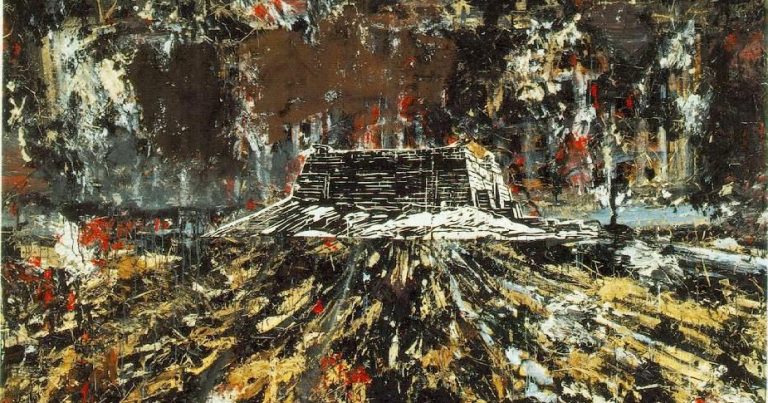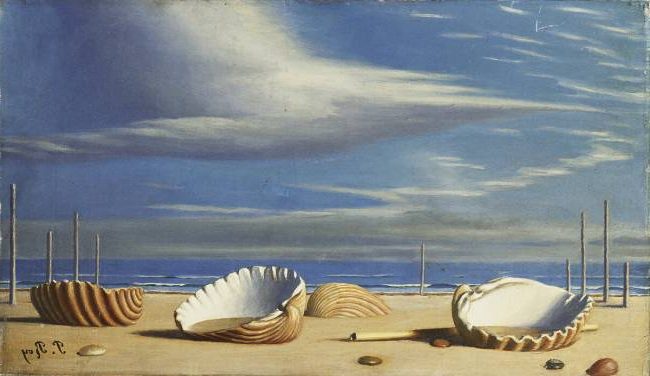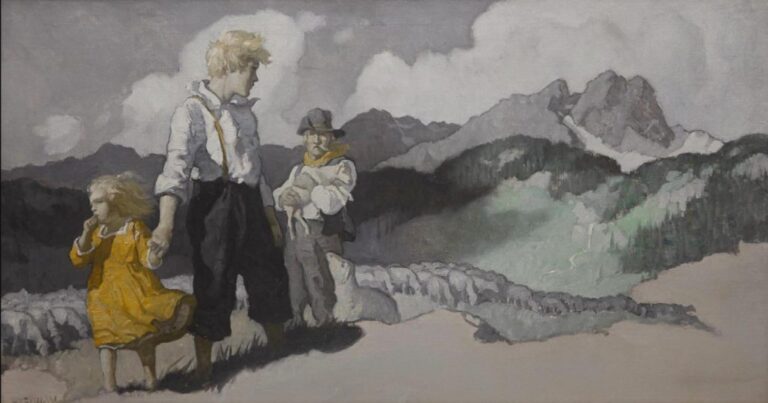Piet Mondrian: Painter Who Revolutionized Abstract Art in the 20th Century
Born: 7 March 1872, Amersfoort, Netherlands
Death: 1 February 1944, New York City, U.S.
Art Movement: De Stijl, Abstract Art
Nationality: Dutch
Influenced By: Pablo Picasso and Georges Braque
Institution: Rijksakademie (Academy of Fine Arts), Amsterdam
Piet Mondrian: Painter Who Revolutionized Abstract Art in the 20th Century
Early Life and Artistic Beginnings
Piet Mondrian began his journey as an artist in late 19th century Holland before evolving into one of the most influential abstract painters of the 20th century. His artistic transformation reflected both his Dutch heritage and his growing interest in spiritual and philosophical ideas.
Influence of Early Dutch Art
Piet Mondrian was born in Amersfoort, Netherlands on March 7, 1872. His father, a qualified drawing teacher, introduced young Piet to art at an early age.

At the Amstel, Sun (1907) by Piet Mondrian
In 1892, Mondrian enrolled at the Academy for Fine Art in Amsterdam. During these formative years, his paintings reflected traditional Dutch artistic values.
His early landscapes captured the serene Dutch countryside with realistic detail. He painted windmills, fields, and rivers in a naturalistic style that honored Holland’s artistic traditions.
Mondrian was particularly drawn to depicting trees, which later became symbolic in his artistic evolution. These early works showed his technical skill and understanding of light, though they gave little hint of his revolutionary future direction.
Transition to Abstract Art
Around 1908, Mondrian’s work began showing influences of Symbolism and Fauvism with brighter colors and simplified forms. His paintings gradually became less representational.
In 1911, Mondrian moved to Paris where he encountered Cubist techniques through the works of Picasso and Braque. This exposure dramatically altered his approach to art.
He began breaking down natural forms into geometric shapes. His tree studies from this period show a fascinating progression from representational to increasingly abstract forms.
By 1914, Mondrian’s paintings featured grids of horizontal and vertical lines. These compositions reflected his growing interest in theosophy and spiritual order.
The outbreak of World War I forced Mondrian to return to Holland, where he continued refining his distinctive abstract style that would eventually lead to his famous primary-colored grid paintings.
Development of Neoplasticism

Evolution (1910–1911) by Piet Mondrian
Neoplasticism emerged as Mondrian’s distinctive artistic philosophy that would reshape modern art in the early 20th century. His methodical approach to abstraction introduced a visual language of horizontal and vertical lines with primary colors that aimed to express universal truths.
Founding of De Stijl Movement
In 1917, Mondrian joined forces with Theo van Doesburg and other Dutch artists to establish De Stijl (The Style). This movement promoted pure abstraction and simplicity through a visual language of straight lines, rectangular forms, and primary colors.
The group published a journal, also called “De Stijl,” where Mondrian articulated his theories about neoplasticism. He believed that reducing art to its most basic elements would reveal universal truths.
World War I significantly influenced the movement’s development. Artists sought a new harmony in art that could help rebuild society after the war’s chaos and destruction.
Evolution of Mondrian’s Style
Mondrian’s artistic journey toward neoplasticism was gradual and methodical. His early works showed naturalistic landscapes, but around 1908, he began experimenting with brighter colors and simplified forms.
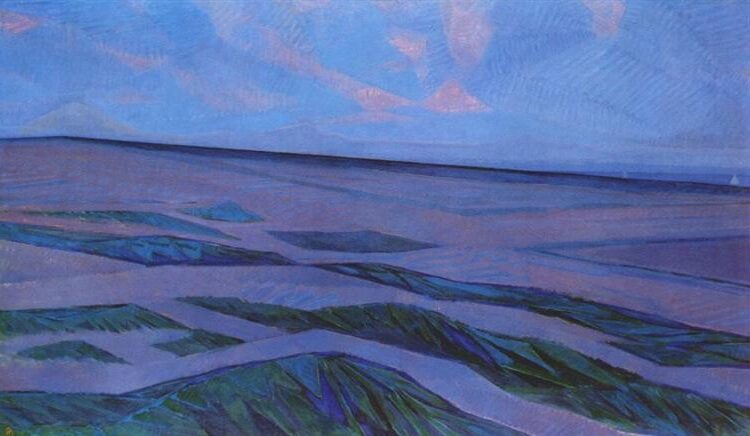
Dune Landscape (1911) by Piet Mondrian
After encountering cubism in Paris in 1911, Mondrian’s work became increasingly abstract. His tree studies from 1912-1914 show his systematic reduction of natural forms to geometric elements.
By 1917, Mondrian had eliminated curved lines entirely. His compositions featured only horizontal and vertical black lines forming rectangles filled with white, gray, and primary colors.
His famous grid paintings emerged in the 1920s. These works achieved perfect asymmetrical balance while using only the most essential elements: straight black lines and blocks of primary colors.
Mondrian’s Artistic Philosophy
Mondrian believed art should express universal principles rather than individual emotions or natural appearances. He sought to create a “pure plastic expression” that reflected cosmic order.
His artistic philosophy rested on the idea of opposites in balance. Vertical lines represented active, masculine energy while horizontal lines symbolized passive, feminine energy.
Mondrian limited his palette to primary colors (red, yellow, blue) plus black, white, and gray. This restriction wasn’t arbitrary—he considered these colors the most fundamental visual elements.
He rejected symmetry in favor of dynamic equilibrium. His careful placement of colored rectangles and black lines created tension and harmony simultaneously, reflecting what he called “dynamic rhythm.”
Legacy and Influence
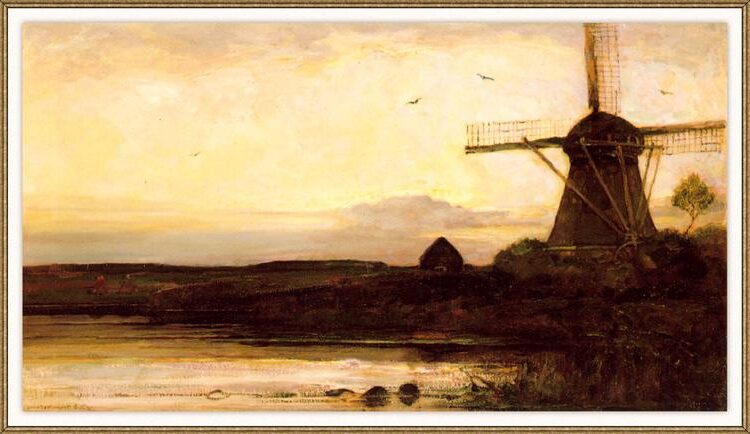
Mill in the Evening (1905) by Piet Mondrian
Piet Mondrian’s distinctive style of geometric abstraction has profoundly shaped modern art and design. His use of primary colors and straight lines continues to resonate across various fields today.
Impact on Modern Art
Mondrian’s contribution to abstract art revolutionized 20th-century painting. His De Stijl movement, characterized by pure abstraction and simplicity, influenced generations of artists who followed him.
After moving to Paris in 1919, Mondrian refined his distinctive style. His grid-based compositions using only primary colors, black lines, and white space became his signature.
The Museum of Modern Art in New York houses several of his most important works, including his final paintings “Broadway Boogie Woogie” and “Victory Boogie Woogie.” These works continue to inspire abstract artists today.
His theories about universal beauty expressed through balanced geometric forms challenged traditional representations and opened new possibilities for visual expression.
Contribution to Design and Architecture
Mondrian’s principles transformed modern design and architecture. His emphasis on simplicity, balance, and primary colors became foundational elements in the Bauhaus movement and International Style architecture.
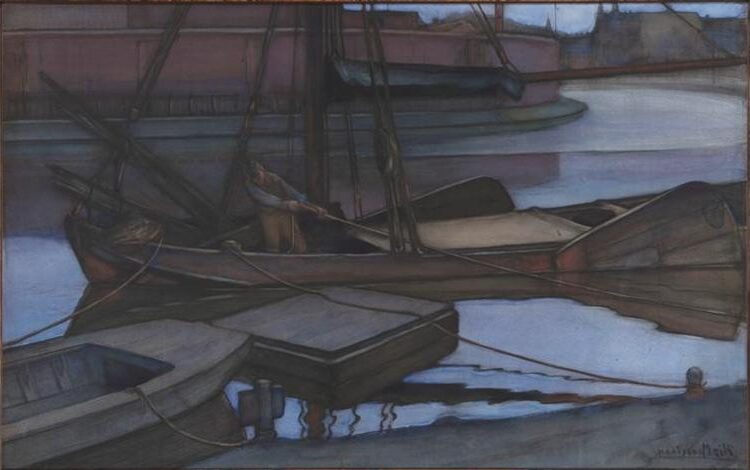
Going Fishing (1900) by Piet Mondrian
Furniture designers embraced Mondrian’s aesthetic, creating chairs, tables, and storage units with clean, geometric lines. The famous “Red and Blue Chair” by Gerrit Rietveld directly translated Mondrian’s artistic vision into three-dimensional form.
Modern buildings with grid-like façades and color blocks reflect his influence. The Eames House in California and numerous buildings by modernist architects show Mondrian’s enduring impact on spatial design.
His concepts of balance and asymmetrical harmony reshaped how designers approach space, proving that beauty can exist in mathematical precision and abstraction.
Mondrian in Popular Culture and Fashion
Mondrian’s distinctive visual style has permeated popular culture. His grid patterns and primary color blocks appear in advertisements, album covers, and digital media.
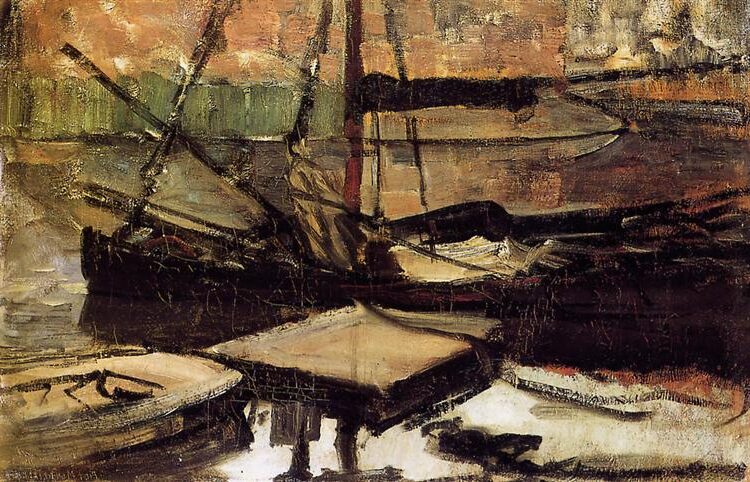
Moored Ships in the Sun (1899) by Piet Mondrian
Fashion designer Yves Saint Laurent created the iconic “Mondrian Collection” in 1965, featuring dresses that directly borrowed Mondrian’s compositions. This collaboration between high art and fashion remains influential decades later.
Television shows, music videos, and films regularly reference Mondrian’s aesthetic. His style appears in everything from “The Simpsons” to sophisticated advertising campaigns.
Consumer products from smartphone cases to bathroom tiles feature Mondrian-inspired designs. His visual language has become so ubiquitous that many people recognize the style without knowing its origin.
Frequently Asked Questions
Piet Mondrian developed a distinctive artistic style that evolved throughout his career and had significant impact on modern art. His work with the De Stijl movement and his philosophical approach to abstract compositions created a lasting legacy in the art world.
What are the defining characteristics of Piet Mondrian’s artistic style?
Mondrian’s mature style features geometric abstraction with straight black lines forming grids on white backgrounds. He used only primary colors—red, yellow, and blue—in rectangular shapes within these grids.
His compositions demonstrate perfect balance and harmony through asymmetry. This approach, which he called “Neo-Plasticism,” eliminated curved lines and naturalistic forms completely.
Mondrian reduced visual elements to their simplest form to express what he believed were universal truths. His precision and mathematical-like approach created a sense of order that became his signature style.
How did Piet Mondrian’s work evolve throughout his career?
Mondrian began as a traditional landscape painter in the Dutch naturalistic style. His early works featured windmills, fields, and other rural Dutch scenes with conventional techniques.
Around 1908, his work showed influences of Impressionism and Symbolism with brighter colors and more expressive brushwork. By 1911, after encountering Cubism in Paris, his paintings became increasingly abstract.
Between 1913 and 1917, Mondrian developed his “plus and minus” compositions with horizontal and vertical lines. This period marked his transition to complete abstraction and laid the groundwork for his iconic grid-based style that emerged in the 1920s.
What role did Piet Mondrian play in the De Stijl movement?
Mondrian co-founded the De Stijl movement in 1917 with Theo van Doesburg in the Netherlands. He wrote extensively for the movement’s journal, helping to define its theoretical foundation.
His ideas about simplification and geometric abstraction became central principles of De Stijl. The movement advocated for universal harmony through pure abstraction and simplified visual elements.
Though Mondrian eventually broke with the group in 1925 due to disagreements with van Doesburg over diagonal lines, his work remained the purest expression of De Stijl principles. His theories and practices established him as the movement’s most influential figure.
How has Piet Mondrian’s approach to color and form influenced modern art?
Mondrian’s work directly influenced the Bauhaus school and Constructivism with his geometric precision and limited palette. His grid-based compositions became foundational for minimalist art in the 1960s.
His influence extends far beyond fine art into design fields. Architecture, furniture design, fashion, and graphic design all show Mondrian’s impact through geometric patterns and primary color schemes.
The iconic Mondrian look appeared in Yves Saint Laurent’s 1965 fashion collection and continues to inspire designers today. His reduction of visual elements to their essential forms revolutionized how artists think about composition and abstraction.
Can you explain the philosophy behind Piet Mondrian’s abstract compositions?
Mondrian developed his approach based on Theosophical beliefs about spiritual evolution and universal harmony. He sought to express cosmic order through the balance of opposing forces—vertical and horizontal, color and non-color.
He believed that by reducing visual elements to their most basic form, he could reveal underlying universal truths. His compositions aimed to create visual equilibrium that reflected the harmony he believed existed in nature at its most fundamental level.
For Mondrian, abstract art wasn’t just aesthetic but spiritual. He wrote that “art should be above reality, otherwise it would have no value for man.” His work attempted to reveal the essential structure behind appearance.
What are some of the most iconic works of art created by Piet Mondrian?
“Broadway Boogie Woogie” (1942-43) reflects Mondrian’s response to New York City’s energy and jazz rhythms. It features a more complex grid pattern. The smaller blocks of color seem to pulse with movement.
“Composition with Red, Blue, and Yellow” (1930) exemplifies his mature Neo-Plastic style. This painting shows perfect balance. It does so through asymmetrically placed primary-colored rectangles within a black grid on a white background.
“Victory Boogie Woogie” (1942-44), Mondrian’s final, unfinished work, shows his style evolving with more complex patterns. Finally, his 1921 “Composition with Large Red Plane, Yellow, Black, Gray and Blue” demonstrates his masterful ability to create dynamic tension through simple elements.






